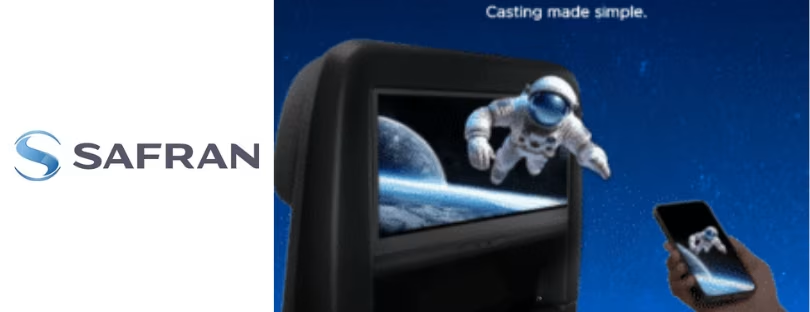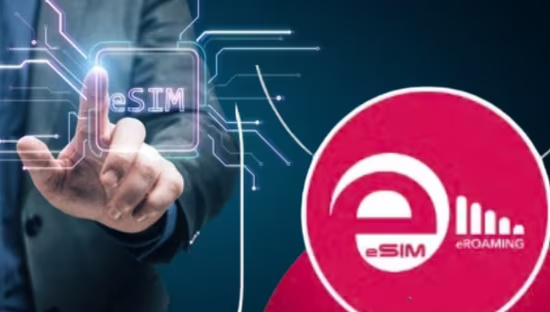
Stream from Your Phone to the Seatback Screen? Yep, That’s (Almost) a Thing Now
Imagine you’re settling into your airplane seat, ready for a long flight. You pull out your phone, find your favorite movie, and instead of squinting at your small screen, you effortlessly cast it onto the seatback screen in front of you. This scenario might soon become a reality, thanks to a new technology unveiled by aerospace company Safran. inflight screencasting
Safran Passenger Innovations (SPI) announces the demonstration of its innovative new Personal Electronic Device (PED) casting solution at the 2025 Aircraft Interiors Expo (AIX). This feature allows passengers to seamlessly connect their personal devices to RAVE In-Flight Entertainment (IFE) displays, enabling them to cast their preferred content directly to the seatback display in front of them.
The Future of Inflight Entertainment
Traditionally, in-flight entertainment has been limited to the options provided by the airline or what you can stream on your personal device. Safran’s new technology aims to bridge this gap by allowing passengers to cast content from their personal devices directly onto the seatback screens. It’s akin to using AirPlay or Chromecast at home, but at 35,000 feet.
This innovation was showcased at the Aircraft Interiors Expo in Hamburg, Germany, where Safran demonstrated how their 4K seatback screens could mirror a passenger’s device. Whether it’s watching a movie, flipping through vacation photos, or even preparing for a business presentation, the possibilities are expansive.
Ben Asmar, SPI’s Vice President of Products and Strategy, says
“As high-speed connectivity is further deployed across the commercial aircraft fleet, airlines must find new ways to engage with passengers as opposed to just losing them to the internet, meaning any opportunity for future engagement becomes significantly harder. The future must be about building connected IFE platforms, where the ‘E’ stands for engagement, allowing the passenger to engage with airline services, third party services and importantly the entertainment options of their choice and not just what is available on board, something we now call the Passenger Curated Experience”
Potential Benefits of inflight screencasting
For travelers, this means a more personalized and comfortable viewing experience. No more propping up your phone or dealing with limited battery life. Business travelers can use the seatback screen as a second monitor, enhancing productivity during flights.
Airlines could also benefit by reducing the need for extensive onboard entertainment libraries, potentially saving on licensing fees and storage requirements. Moreover, offering such personalized experiences could enhance customer satisfaction and loyalty.
Developed in partnership with IdeaNova Technologies, Inc. (a leader in secure video streaming and advanced engineering), these revolutionary solutions represent a leap forward in in-flight entertainment. Designed to transform the passenger experience, they seamlessly combine cutting-edge technology with passenger innovation, setting a new benchmark for immersive, passenger-curated entertainment in the skies. inflight screencasting
Matt Smith, CEO of Safran Passenger Innovations, emphasizes,
“Connectivity is revolutionizing the onboard passenger experience, unlocking exciting new avenues for entertainment and engagement. To fully leverage the potential of virtually limitless entertainment options for passengers, it is essential for SPI to have a robust platform that supports this evolution. This is why we are committed to investing in an Open Platform powered by Cloud Services, enabling us to quickly adapt to emerging technologies. In many cases, we can deliver updates to unlock these capabilities for our customers through software updates, without the need for new hardware.”
Challenges Ahead
However, implementing this technology isn’t without its challenges. One major concern is content control. Airlines need to ensure that inappropriate content isn’t displayed on seatback screens, especially in a shared environment. Safran acknowledges this and mentions that airlines will have the authority to determine what content is permissible.
Another hurdle is the potential licensing issues with streaming services. Casting content from platforms like Netflix or Disney+ might violate their terms of service or require additional agreements. Airlines and technology providers will need to navigate these legal intricacies carefully.
While the technology is promising, its adoption might vary across regions. Safran notes that airlines in the U.S. and Europe are currently hesitant, whereas carriers in other parts of the world have shown more interest. This disparity could be due to differing regulatory environments, customer expectations, or operational considerations.
It’s also worth noting that other airlines are making strides in enhancing in-flight entertainment. For instance, United Airlines is equipping its fleet with Bluetooth-enabled seatback screens, allowing passengers to use their wireless headphones. Delta Air Lines is also expanding Bluetooth connectivity and introducing ad-free streaming partnerships.
Inflight Screencasting Looking Ahead
The introduction of screencasting technology marks a significant step toward more personalized in-flight experiences. As airlines strive to differentiate themselves and cater to evolving passenger preferences, such innovations could become standard in the near future.
However, successful implementation will require careful consideration of content control, licensing agreements, and passenger privacy. As the industry navigates these challenges, passengers can look forward to a more integrated and enjoyable in-flight entertainment experience.











